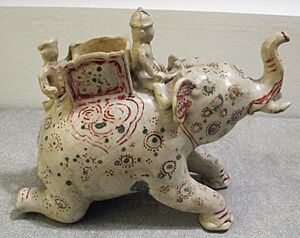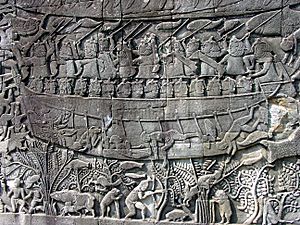Khmer–Cham wars facts for kids
The Khmer–Cham wars were a series of big fights between two powerful kingdoms in Southeast Asia: the Khmer Empire and Champa. Later, another kingdom called Đại Việt also got involved. These wars happened from the mid-900s to the early 1200s.
The first conflict started around 950 AD. Khmer soldiers attacked a Cham area called Kauthara. Tensions grew a lot in the mid-1100s, leading to huge wars. The fighting finally ended in 1220 when the Khmer army left Champa.
Contents
A Long History of Wars
First Attack: Khmer Invade Kauthara (950)
Around 950, the Khmer army, led by King Rajendravarman II, marched through forests. They attacked the Po Nagar temple in Kauthara, a Cham area. They took a golden statue of Bhagavati, which was a very important Cham goddess. However, this invasion ended badly for the Khmer.
In 965, the Cham King Jaya Indravaman I rebuilt the temple. He also replaced the stolen goddess statue.
More Khmer Attacks on Champa (1074–1080)
In 1074, Harivarman IV became the king of Champa. He had good connections with Song China and made peace with Dai Viet. But he started a war with the Khmer Empire.
In 1080, a Khmer army attacked Vijaya, a major city in northern Champa. They also attacked other Cham towns. Temples and monasteries were raided, and valuable treasures were taken. After a lot of trouble, Cham troops led by King Harivarman defeated the invaders. They rebuilt their capital and temples. Later, Harivarman's forces raided Cambodia. They went as far as Sambor and the Mekong River, destroying religious sites there.
King Suryavarman II's Many Wars (1128–1150)
In 1127, the Khmer king Suryavarman II demanded that the Vietnamese king Lý Thần Tông pay tribute to the Khmer Empire. The Vietnamese king refused. So, Suryavarman decided to expand his kingdom north into Vietnamese land.
His first attack was in 1128. King Suryavarman led 20,000 soldiers to Nghệ An, Vietnam. But they were defeated in battle. The next year, Suryavarman continued small fights on land. He also sent 700 ships to attack the coast of Đại Việt. In 1132, he convinced the Cham king Jaya Indravarman III to join him. Together, they attacked Đại Việt. They briefly took Nghệ An and raided coastal areas of Thanh Hoá.
In 1136, a Vietnamese army, led by Đỗ Anh Vũ, attacked the Khmer Empire. They marched through what is now Laos with 30,000 men. But they later retreated. After this, the Cham made peace with the Vietnamese. When Suryavarman attacked again, Jaya Indravarman refused to help the Khmer.
After failing to capture seaports in southern Đại Việt, Suryavarman turned to invade Champa in 1145. He attacked Vijaya, ending the rule of Jaya Indravarman III. He also destroyed temples at Mỹ Sơn. In 1147, a Cham prince named Sivänandana became King Jaya Harivarman I of Champa. Suryavarman sent an army of Khmer and Cham soldiers who had switched sides. This army was led by a commander named Sankara. But they were defeated by Harivarman in the battle of Räjapura in 1148. Another, stronger Khmer army also lost battles at Virapura and Caklyaṅ.
Since he couldn't defeat the Cham, Suryavarman made Prince Harideva, a Cham prince with Cambodian family, the puppet king of Champa in Vijaya. In 1149, Harivarman marched his army north to Vijaya. He surrounded the city and defeated Harideva's army. He then executed Harideva and all his Cambodian-Cham officials and soldiers. This ended Suryavarman's control of northern Champa. Harivarman then reunited the kingdom. A prince who wanted to be king, Vamsaraja, attacked Harivarman with mountain troops. But he was defeated and escaped to Đại Việt. Later, Vamsaraja was crushed and killed by Harivarman during the Battle of Mỹ Sơn in 1150.
Champa Fights Back: Invading Angkor (1170, 1177–1181)
After making peace with Đại Việt in 1170, Cham forces, led by Jaya Indravarman IV, invaded the Khmer Empire by land. The results were not clear. That year, a Chinese official saw battles where Cham and Khmer armies fought with elephants. This made the Cham king want to buy war horses from China. But China refused many times.
In 1177, however, Cham troops launched a surprise attack on the Khmer capital, Yasodharapura. They used warships that sailed up the Mekong River to the great lake Tonlé Sap. They killed the Khmer king Tribhuvanadityavarman. New weapons, like multiple-bow siege crossbows, came to Champa from Song dynasty in 1171. These were later put on the backs of Cham and Vietnamese war elephants. The Cham used them during the attack on Angkor, which was only protected by wooden fences. This led to the Cham taking over Cambodia for the next four years.
The Khmer Empire was almost collapsing. Jayavarman VII from the north gathered an army to fight the invaders. He had fought against the Chams when he was younger, in the 1140s. He had even been part of a campaign in the Cham capital, Vijaya. His army won many battles against the Cham. By 1181, after winning a very important naval battle, Jayavarman had saved the empire and forced the Cham out.
King Jayavarman VII Conquers Champa (1190–1203)
In 1190, the Khmer king Jayavarman VII chose a Cham prince named Vidyanandana to lead the Khmer army. Vidyanandana had joined Jayavarman in 1182 and had been educated in Angkor. Vidyanandana defeated the Chams. He then took over Vijaya and captured Jaya Indravarman IV, sending him as a prisoner to Angkor.
Vidyanandana called himself Shri Suryavarmadeva (or Suryavarman). He became king of Panduranga, which was now controlled by the Khmer. He also made Prince In, who was Jayavarman VII's brother-in-law, "King Suryajayavarmadeva in the Nagara of Vijaya." In 1191, a rebellion in Vijaya forced Suryajayavarman back to Cambodia. Jaya Indravarman V became king. Vidyanandana, with help from Jayavarman VII, took Vijaya back. He killed both Jaya Indravarman IV and Jaya Indravarman V. Then he ruled Champa without anyone opposing him. He declared that he was independent from the Khmer Empire.
Jayavarman VII responded by invading Champa several times: in 1192, 1195, 1198–1199, and 1201-1203. The Khmer also started using double-bow crossbows on elephants. Some historians think these might have come from Cham soldiers who joined Jayavarman VII's army.
Khmer armies under Jayavarman VII kept fighting in Champa until the Chams were finally defeated in 1203. A Cham prince who had turned against his own people, ong Dhanapatigräma, overthrew and sent his nephew Vidyanandana/Suryavarman to Dai Viet. This completed the Khmer conquest of Champa.
From 1203 to 1220, Champa was like a Khmer province. It was ruled by a puppet government led first by ong Dhanapatigräma, and then by Prince Angsaräja. Angsaräja was the son of Jaya Harivarman I. He would later become Jaya Paramesvaravarman II. In 1207, Angsaräja joined a Khmer army that included soldiers from Burma and Siam. They fought against the Yvan (Dai Viet) army.
After the Khmer army slowly left Champa in 1220, Angsaräja took control peacefully. He declared himself Jaya Paramesvaravarman II and brought back Champa's independence.
See also
- Sino–Cham war
- History of the Cham–Vietnamese wars



